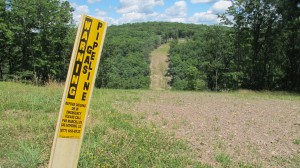Mind ‘the gap’: why more gas means more pipelines
-
Marie Cusick
Pennsylvania is producing more gas than it knows what to do with. Amid a push to export gas to foreign markets, there’s also a shift away from coal toward gas at electric power plants. Right now the state gets about 20 percent of its electricity from gas, but that’s expected to increase significantly.
All these changes are leading to an ongoing expansion of gas-related infrastructure– primarily pipelines.
Anthony Cox, of UGI Energy Services, spoke with StateImpact Pennsylvania Tuesday during Penn State’s Natural Gas Utilization Conference in Cannonsburg.
He describes the need for pipelines as an “infrastructure gap” problem that causes supply to be out of balance with demand.
Note: this interview has been edited for length and clarity.
Q: What is this infrastructure gap?
A: I’d describe it as a dumbbell. One side of the dumbbell—you have a major source of production and supply. And on the other end you have a major source of demand.
And in the middle you have a thin bar, and that bar is the infrastructure gap. That needs to be built, basically, to bridge the two ends of the dumbbell.
Q: What happened last winter with electricity prices spiking?
A: Last winter, simply, the middle—in between the two [ends of the dumbbell]– was just too small. We saw unprecedented demand, particularly in the mid-Atlantic region, Philadelphia, New Jersey, and New York. There was certainly enough supply, but it couldn’t get to where it was needed.
Q: Was it all gas causing the price spikes? We get a lot of electricity from coal and nuclear too.
A: It was predominantly gas-fired generation as well as other sources of demand. As the economy has picked up speed, we’ve seen unprecedented numbers of conversions for home heating, industrial growth. Then add to that a significant increase in the amount of electricity that’s generated from natural gas and cold weather.
All those things combined led to extremely high levels of demand– unlike we’ve ever seen before. That’s what led to the high prices.
Q: How is a gas-fired power plant different from coal or nuclear? A coal plant has coal on site, and a nuclear plant can run for a couple years without refueling. But gas is different, right?
A: With gas there’s no place on-site to stockpile the natural gas. So it has to rely on firm space in pipelines. When I say “firm” I mean uninterruptable space in pipelines to move the gas to the power plant from a production area or from a storage field.
Q: Is there a good analogy for this? Is the pipeline like a road going to the power plant?
A: You have to buy your own truck on the road. The pipelines are the highways; the capacity would be the trucks.
Q: Is that going to be a problem moving forward as we use more gas for electric generation? The fact that it’s not sitting on–site like some of these other power sources?
A: Yes, it’s an issue. It’s an issue for any fuel that’s used for making electricity that doesn’t have a way to either store it on-site after it’s made. Even renewables have a significant problem because they can make lots of power, but if they don’t have a place to store it on-site, there’s a disconnect between supply and demand.
Q: So for wind and solar, you hear about batteries and energy storage technologies emerging as a possible solution. What’s the solution for gas?
A: Infrastructure. And it doesn’t take a lot. It’s not going to take a lot of pipeline to get that supply and demand equilibrium back into check, but you need to have it. Because when it’s out of check, the results are fairly dramatic.
Q: What about people who are upset about an interstate transmission project in their community? For example, they’ll say, “It’s not going to help me out.”
A: You have to look beyond the immediate use of natural gas. And we hear that a lot. We hear, “If I can’t tap into that pipeline and I can’t use that natural gas in my house, I’m not going to benefit.” And the reality is that’s simply not true. There’s a much bigger, macroeconomic story that starts with electric generation and starts with eliminating volatility on natural gas and electricity prices that impacts everybody. It goes to increased natural gas usage which leads to increased competitiveness for local businesses, which increases jobs. So there’s a much bigger macroeconomic story to be told here.

















